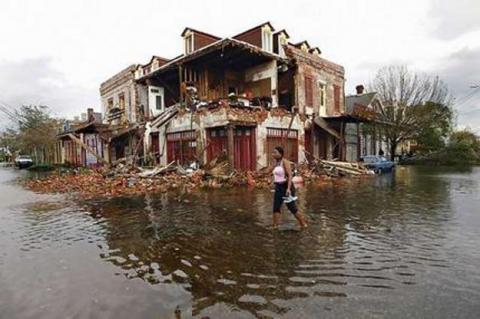Gary Rivlin’s ‘Katrina’ Portrays a Destroyed City and Its Painful Recovery

Katrina: After the Flood
Gary Rivlin
Simon & Schuster
480 pages
Two moments seem emblematic of the squalid presidency of George W. Bush. On May 1, 2003, soon after launching the war in Iraq, Bush stood in a flight jacket aboard the aircraft carrier USS Abraham Lincoln and addressed troops under a banner proclaiming “Mission Accomplished.” On September 2, 2005, at the Mobile, Alabama Regional Airport, Bush praised FEMA Director Michael Brown for coordinating disaster relief in the wake of Hurricane Katrina – “Brownie, you’re doing a heck of a job!”—while thousands of Americans were fighting simply to survive.
But as Gary Rivlin’s new book, Katrina: After the Flood, amply demonstrates, when it comes to analyzing the failure to rescue a major American city at its time of greatest need, there’s plenty of blame to go around.
Katrina opens with a compelling set piece that encapsulates many of the book’s themes—the chaos after Katrina made landfall, the lack of emergency coordination among local officials, dire situations made worse by crippling issues of race. On August 30, a group of predominantly black residents, seeking to escape flooding and destruction in their neighborhoods, crossed a bridge spanning the Mississippi for the relative safety of suburban Gretna, a predominantly white community.
As Rivlin reports, the exodus was halted by a police barricade and refused entry:
“The second and third buses pulled up, and they, too, disgorged their passengers there at the Gretna bus terminal. There, on this large patch of sidewalk under a highway overpass, the police pointed shotguns and other long guns … Gretna, a town of eighteen thousand whose official motto is ‘Small City, Big Heart,’ had lost electricity, but still had plenty of food and water on stock. Its roads were passable, providing people a path to safety. [Sharon] Paul said she heard one cop yell, ‘Get on the curb now or we’re gonna shoot,’ but she couldn’t take the command seriously. ‘They cocked their guns,’ Paul said, ‘and then everybody paid attention …”
This frenzied confrontation was in many ways an omen of what was yet to come.
Last August marked Hurricane Katrina’s 10-year anniversary. It would be nice to believe the devastation in New Orleans East and the Lower Ninth Ward has been repaired and relations between rich and poor restored, but Rivlin’s thorough reporting indicates such is not the case.

A former New York Times reporter, Rivlin conducted interviews with hurricane survivors (those who stayed on in New Orleans and those forced by circumstances to move elsewhere), and others from the many-layered economic substratum in that class-ridden city. His sobering tale is leavened by a tone of disappointment that, in the weeks immediately following the disaster, so many well-meaning people could get things so wrong.
In the earliest days, after Category 3 winds and rain pummeled the region, the wreckage was nearly unimaginable:
“A permanent stench infected New Orleans, even parts that had remained dry—like the seaside community near the end of summer, except that the brackish smell was mixed, not with the odor of rotting alewives, but with hints of oil, sewage, rancid meat, and death. Decaying human bodies were cooking in the intense New Orleans heat along with those of cats, dogs, and other animals that had been caught in the flooding.”
The most inspiring moments in Katrina: After the Flood come from a handful of people who tried meeting the challenges of recovery head-on. Alden J. McDonald, president of New Orleans’ largest black-owned bank, and businessmen David White and Joseph Canizaro, among others, fought bureaucratic red tape and other obstacles to hasten recovery. Their efforts were often as not unsuccessful, but they emerge from these pages as heroic figures wanting to help wherever they could.
Ray Nagin, the city’s then-Mayor, is portrayed in a less flattering light. According to Rivlin, he was from the outset woefully ill-equipped to handle the overwhelming challenges of his office. Squabbles with local and federal officials (not excluding the President of the United States) hampered his efforts to secure emergency funding and keep critically needed repairs on track. Nagin did little to mend the schisms between blacks and whites at a time when some form of unity would have been invaluable.
At times, the book bogs down in procedural descriptions of committees and commissions set up to plot the city’s recovery. In the end, however, Katrina: After the Flood succeeds as a lucid and sympathetic account of a vital American metropolis crushed by natural forces and beset by issues of race and class in its ongoing attempts to recover.
Author Bio:
Lee Polevoi is Highbrow Magazine’s chief book critic.





























































































































































































































































































































